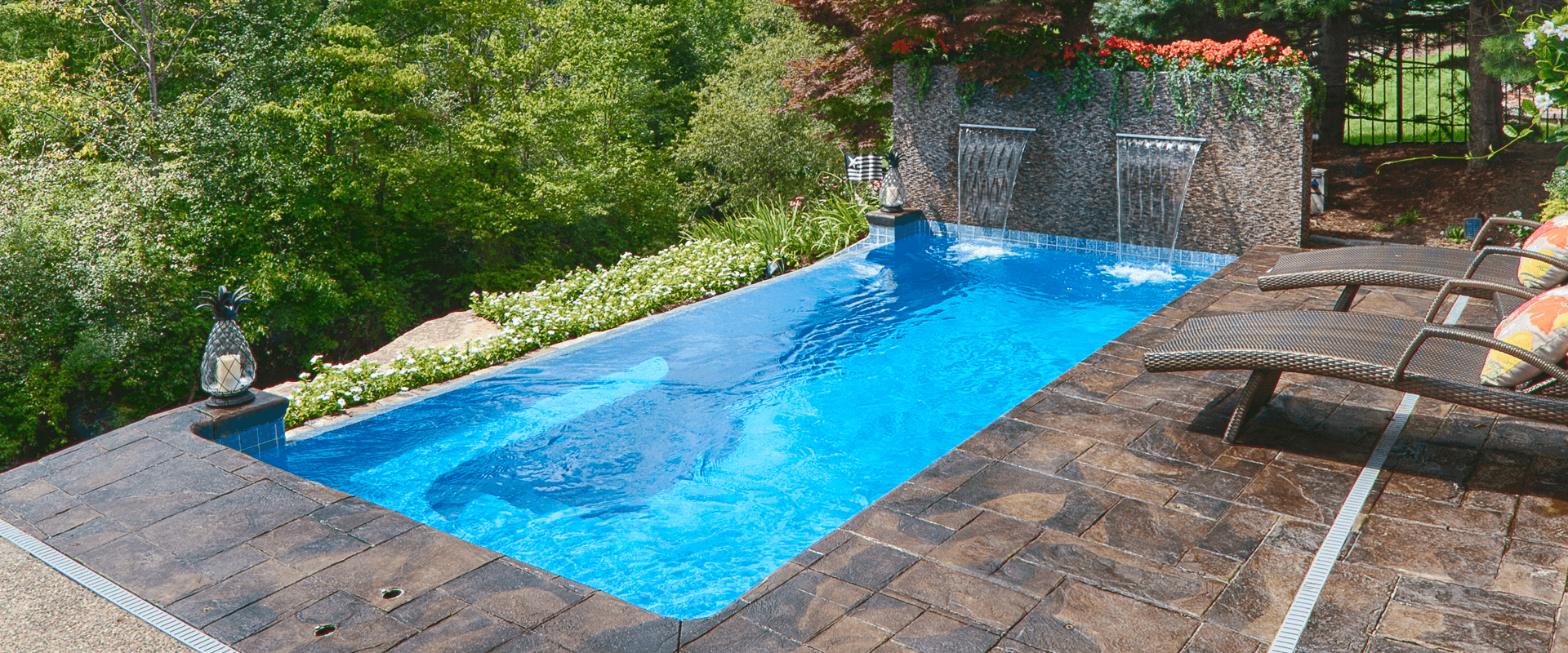877-929-7665
What Does Routine Fiberglass Pool Maintenance Look Like?
Benefits of owning a fiberglass pool include reduced upkeep demands and the guarantee of continuous enjoyment during the warmer months. However, it’s essential to recognize that consistent maintenance efforts are still necessary. Maintaining pool water chemistry is critical to ensure your pool remains a radiant and inviting space to spend time with family and friends.
Starting the Season Right
Opening your fiberglass pool marks the commencement of the swimming season and sets the stage for a season of fun and relaxation. Once you open your pool, commit to conducting daily tests to adjust your pool’s chemistry until the water’s chemistry factors fall within the following ranges:
- pH: 7.2 to 7.4
- Total Alkalinity (TA): 80 to 120 ppm
- Cyanuric Acid (CYA): 30 to 50 ppm
- Calcium Hardness (CH): Less than 120 ppm (do not add calcium)
- Total Dissolved Solids (TDS): Less than 1,500 ppm (or up to 1,000 ppm above your salt level)
This crucial first step ensures your pool water is neither too corrosive nor scaling, protecting the integrity and appearance of the fiberglass gel coat.
Maintaining Chlorine Levels
Once your fiberglass pool’s other water chemistry factors are within the recommended ranges, adding sanitizer maintains chlorine levels within a safe range of 1 to 3 parts per million (ppm), optimal for disinfecting the pool without damaging the fiberglass surface. Monitoring and adjusting chlorine levels is a fundamental aspect of routine maintenance that keeps the water clear, clean, and safe for swimmers.
Weekly Checks and Adjustments
Your pool’s water chemistry can quickly fluctuate even after establishing a balanced baseline due to various events such as changes in swimmer load, weather conditions, organic debris, water evaporation, and more. Perform weekly tests to monitor water chemistry, checking the chlorine, pH, alkalinity, and other factors are within recommended ranges. These regular check-ins help catch and correct minor imbalances before they become bigger issues.
Water Level and Filtration Maintenance
Maintaining the pool’s water level is another vital aspect of routine care. The water level should always be halfway to the top of the skimmer window to ensure efficient filtration and circulation. Regularly check and clean the filter and skimmer baskets to prevent clogs and maintain proper function. Vacuuming your pool to remove debris and sediment keeps the water clearer and reduces the strain on your pool’s filtration system.
Gentle Cleaning for Long-Lasting Shine
The non-porous gelcoat surface of fiberglass pools is highly stain-resistant, making cleaning a breeze. A soft microfiber cloth, sponge, or pool brush with nylon bristles should suffice. Some household cleaners contain harsh chemicals unsuitable for fiberglass pool surfaces and may cause damage over time. Always use cleaners specifically designed for fiberglass pools, as aggressive cleaning agents can damage the gelcoat, leading to unnecessary wear and repair costs. Metal scrapers or putty knives can gouge or scratch the fiberglass when used to remove debris or scale. Avoid using highly abrasive tools such as wire and stiff-bristle brushes or steel wool.
The Value of Prevention
In pool maintenance, an ounce of prevention is worth a pound of cure. Regular, proactive care keeps your pool looking and performing its best and extends the life of your investment. Fortunately, the inherent durability and ease of care with fiberglass pools mean that maintaining balanced water chemistry requires less effort than you might think. Test kits and resources such as the Thursday Pools Fiberglass Pool Care Guide can help quickly provide direction on how to balance your pool water best.
Understanding Low Maintenance Isn’t Maintenance-Free
While we celebrate fiberglass pools for their low maintenance needs, it’s important to remember that “less maintenance” doesn’t mean “maintenance-free.” The foundation of a healthy, long-lasting pool is achieving balanced water chemistry through frequent and routine testing, precise adjustments, and regular cleaning. By embracing these responsibilities, you’ll ensure your pool remains a beautiful source of joy, relaxation, and pride.
Looking for more information on fiberglass pool care? Explore Thursday Pools’ Ultimate Fiberglass Pool Maintenance Guide for a thorough look at everything you need to know.
And if you’re ready for personalized advice, connect with a local independent Thursday Pools dealer near you.
Routine Fiberglass Pool Maintenance Frequently Asked Questions
-
How often should I test my fiberglass pool water?
Test your pool daily when you first open it for the season until the critical water chemistry factors remain within the recommended ranges. After that, weekly tests help keep chlorine, pH, and alkalinity levels in check.
-
What’s the ideal chlorine level for a fiberglass pool?
Keep free chlorine between 1 and 3 ppm. This range keeps the water safe and sparkling without damaging the fiberglass gelcoat.
-
How should I clean my fiberglass pool surface?
Use a soft microfiber cloth, sponge, or a nylon-bristle pool brush. Avoid harsh chemicals, stiff brushes, or metal tools that can scratch or damage the gelcoat.
-
Where should my pool water level be for proper circulation?
Keep the water level halfway up the skimmer window to ensure the filtration system runs efficiently and helps prevent pump and skimming issues.
-
Do fiberglass pools really need less maintenance than other pools?
Yes, it is widely accepted in the pool industry that fiberglass pools are lower maintenance than other pool types. However, “less maintenance” doesn’t mean “maintenance-free.” Fiberglass pools resist algae and staining, so they require fewer chemicals and less scrubbing, but you still need regular testing, cleaning, and filter care to maintain your pool’s aesthetic and longevity.
